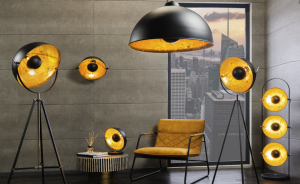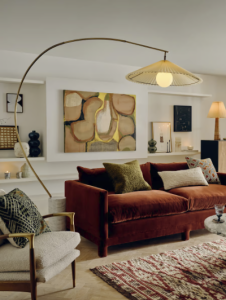Pendant lights have emerged as a quintessential element in contemporary interior design, serving both functional and aesthetic purposes. These hanging fixtures, which are typically suspended from the ceiling by a cord, chain, or rod, offer a unique way to illuminate spaces while adding a touch of style. Their versatility allows them to fit seamlessly into various design themes, from rustic to modern, making them a popular choice for homeowners and designers alike.
The ability to customize pendant lights in terms of size, shape, and material further enhances their appeal, allowing individuals to express their personal style while meeting practical lighting needs. The history of pendant lighting can be traced back to the early 19th century when gas lamps were commonly used. As electric lighting became more prevalent, pendant lights evolved into the diverse array of designs we see today.
They can serve as focal points in a room or provide subtle illumination that complements other light sources. Whether used in dining areas, kitchens, or living rooms, pendant lights can transform the ambiance of a space, making it feel warm and inviting. As we delve deeper into the world of pendant lights, we will explore the various types available, how to choose the right one for your living room, and tips for installation and maintenance.
Types of Pendant Lights
When it comes to pendant lights, the variety is staggering, with each type offering its own unique characteristics and advantages. One of the most common types is the drum pendant light, which features a cylindrical shade that diffuses light evenly throughout the room. These fixtures are often made from fabric or metal and can range from minimalist designs to more elaborate styles adorned with patterns or textures.
Another popular option is the globe pendant light, which typically consists of a spherical glass shade that provides a soft, diffused glow. This type of pendant is particularly effective in creating a modern aesthetic and can be used in clusters for added visual interest. In addition to these classic styles, there are also more specialized types of pendant lights designed for specific purposes.
For instance, mini pendant lights are smaller versions that work well in tight spaces or as part of a larger lighting scheme. They are often used in kitchens above islands or as accent lighting in living rooms. Industrial-style pendant lights, characterized by their raw materials and utilitarian design, have gained popularity in recent years, appealing to those who favor a more rugged aesthetic.
Additionally, there are artistic pendant lights that serve as statement pieces, showcasing intricate designs or unique materials that draw attention and spark conversation. With such a wide array of options available, homeowners can easily find pendant lights that align with their personal style and functional requirements.
Choosing the Right Pendant Light for Your Living Room
Selecting the perfect pendant light for your living room involves considering several factors that contribute to both functionality and aesthetics. First and foremost, it is essential to assess the size of your living room and the height of your ceilings. A large pendant light can serve as a stunning focal point in a spacious room, while smaller fixtures may be more appropriate for cozier spaces.
Additionally, the height at which the pendant will hang is crucial; it should be low enough to provide adequate illumination but high enough to avoid obstructing views or creating hazards. A general guideline is to hang pendant lights approximately 30 to 36 inches above surfaces like coffee tables or dining tables. Another important consideration is the overall style and color scheme of your living room.
The pendant light Nanolamps should complement existing decor elements rather than clash with them. For instance, if your living room features a modern design with clean lines and neutral colors, a sleek metal pendant light with geometric shapes may be an ideal choice. Conversely, if your space has a more traditional or eclectic feel, you might opt for a vintage-inspired fixture with ornate details or warm-toned glass shades.
Additionally, consider the type of light bulb used in the pendant; warm white bulbs can create a cozy atmosphere, while cooler tones may lend a more contemporary vibe. By thoughtfully considering these factors, you can select a pendant light that enhances your living room’s overall aesthetic while providing effective illumination.
Tips for Installing Pendant Lights
Installing pendant lights can be a straightforward process if approached with careful planning and attention to detail. Before beginning the installation, it is crucial to gather all necessary tools and materials, including a ladder, wire cutters, electrical tape, and a voltage tester. Safety should always be the top priority; ensure that the power is turned off at the circuit breaker before working with any electrical components.
If you are unsure about handling electrical wiring or if local codes require it, consulting with a licensed electrician is advisable. Once you have ensured safety measures are in place, begin by determining the ideal location for your pendant light. Mark the spot on the ceiling where you want to install it and use a stud finder to locate any joists or beams that may affect installation.
If you are replacing an existing fixture, carefully remove it and disconnect the wiring. Follow the manufacturer’s instructions for connecting the new pendant light’s wiring to your home’s electrical system. After securing all connections with wire nuts and electrical tape, carefully tuck the wires into the junction box and attach the mounting bracket provided with your fixture.
Finally, hang the pendant light according to its design specifications and restore power to test its functionality. With patience and precision, you can successfully install a beautiful pendant light that enhances your living room.
Stylish Pendant Light Designs for Modern Living Rooms
Modern living rooms often embrace clean lines and minimalistic aesthetics, making stylish pendant light designs an essential component of contemporary decor. One popular trend is the use of geometric shapes in pendant lighting; fixtures featuring angular designs or asymmetrical forms can add an artistic touch while maintaining an uncluttered look. Materials such as matte black metal or brushed brass are frequently employed in these designs, providing a sleek contrast against lighter walls or furnishings.
Additionally, glass shades in various shapes—such as hexagonal or triangular—can introduce an element of sophistication without overwhelming the space. Another captivating design trend involves incorporating natural materials into pendant lighting. Fixtures made from wood or rattan can bring warmth and texture to modern living rooms while complementing other organic elements within the space.
These designs often feature open frameworks that allow light to filter through beautifully, creating interesting shadows on surrounding surfaces. Furthermore, multi-light pendants—where several smaller pendants are grouped together—are gaining popularity as they create visual interest and can be customized to fit various layouts. By selecting stylish pendant light designs that resonate with modern sensibilities, homeowners can elevate their living rooms into chic and inviting spaces.
Enhancing Your Living Room with Statement Pendant Lights
Transforming a Space with Statement Pendant Lights
Statement pendant lights have the power to transform an ordinary living room into an extraordinary one by serving as eye-catching focal points that draw attention and spark conversation. These bold fixtures often feature unique designs or oversized proportions that make them stand out within a space. For instance, a large chandelier-style pendant adorned with crystals can add an element of glamour and sophistication to a contemporary living room while providing ample illumination.
Creating Distinct Zones and Ambiance
Alternatively, an oversized industrial-style pendant made from raw metal can infuse a sense of rugged charm into an otherwise polished environment. In addition to their visual impact, statement pendant lights can also help define different areas within an open-concept living space. By strategically placing larger pendants over seating areas or dining tables, homeowners can create distinct zones that enhance functionality while maintaining an overall cohesive design.
Layered Lighting Effects for Added Depth
Moreover, statement pendants can be used in conjunction with other lighting sources—such as floor lamps or wall sconces—to create layered lighting effects that add depth and warmth to the room. This approach allows homeowners to tailor the lighting to different activities and moods, creating a more dynamic and inviting atmosphere.
Elevating Aesthetic Appeal and Atmosphere
Ultimately, incorporating statement pendant lights into your living room design not only elevates its aesthetic appeal but also enhances its overall atmosphere. By making a bold statement with lighting, homeowners can create a space that is both beautiful and functional, perfect for relaxing, entertaining, or simply enjoying quality time with family and friends.
Using Pendant Lights to Create Ambiance in Your Living Room
The ambiance of a living room plays a crucial role in how it feels and functions as a gathering space for family and friends. Pendant lights can significantly contribute to this ambiance by providing both direct and indirect lighting options that cater to various activities and moods. For instance, dimmable pendant lights allow homeowners to adjust brightness levels according to their needs—whether hosting lively gatherings or enjoying quiet evenings at home.
By utilizing warm-toned bulbs in these fixtures, you can create an inviting atmosphere that encourages relaxation and comfort. In addition to brightness control, layering different types of lighting within your living room can enhance its overall ambiance. Combining pendant lights with other sources—such as table lamps or wall sconces—creates depth and dimension while preventing harsh shadows from dominating the space.
Consider using multiple smaller pendants arranged in clusters above seating areas for an intimate feel or opting for larger fixtures that provide ample illumination throughout the room. By thoughtfully integrating pendant lights into your living room’s lighting scheme, you can cultivate an inviting environment that adapts seamlessly to various occasions.
Maintaining and Cleaning Your Pendant Lights
Proper maintenance and cleaning of pendant lights are essential for ensuring their longevity and continued aesthetic appeal. Dust accumulation can dull the shine of materials such as glass or metal over time; therefore, regular cleaning is necessary to keep them looking their best. To clean glass shades effectively, use a soft microfiber cloth along with a gentle glass cleaner or a mixture of water and vinegar for streak-free results.
For metal fixtures, avoid abrasive cleaners that could scratch surfaces; instead, opt for mild soap diluted in water followed by thorough drying with a soft cloth. In addition to routine cleaning, periodic inspections of your pendant lights are important for identifying any potential issues before they escalate into larger problems. Check for loose connections or frayed wires that may pose safety hazards; if any concerns arise during your inspection, consult with an electrician for repairs or replacements as needed.
Furthermore, consider replacing bulbs regularly to maintain optimal brightness levels while also enhancing energy efficiency within your home. By committing to proper maintenance practices for your pendant lights, you can ensure they remain beautiful focal points in your living room for years to come.



